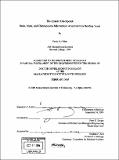| dc.contributor.advisor | Peter S. Sorger. | en_US |
| dc.contributor.author | Gillett, Emily S., 1976- | en_US |
| dc.contributor.other | Massachusetts Institute of Technology. Dept. of Biology. | en_US |
| dc.date.accessioned | 2005-09-27T19:08:57Z | |
| dc.date.available | 2005-09-27T19:08:57Z | |
| dc.date.copyright | 2004 | en_US |
| dc.date.issued | 2005 | en_US |
| dc.identifier.uri | http://hdl.handle.net/1721.1/28934 | |
| dc.description | Thesis (Ph. D.)--Massachusetts Institute of Technology, Dept. of Biology, February 2005. | en_US |
| dc.description | Includes bibliographical references. | en_US |
| dc.description.abstract | (cont.) DNA damage response, we hypothesize that the perinuclear pool of Mad proteins may be required for spindle checkpoint-independent functions such as invoking metaphase arrest following DNA damage. | en_US |
| dc.description.abstract | The high fidelity of chromosome transmission in eukaryotes is achieved, in part, by the activity of the spindle checkpoint. This checkpoint monitors the status of chromosome-microtubule attachments and delays the onset of anaphase until all kinetochores have formed stable bipolar connections to the mitotic spindle. We have characterized the localization of the Bub and Mad spindle checkpoint proteins in Saccharomyces cerevisiae. In metazoan cells, all known spindle checkpoint proteins are recruited to kinetochores during normal mitoses. In contrast, we show that whereas S. cerevisiae Bublp and Bub3p are bound to kinetochores early in mitosis as part of the normal cell cycle, Madlp and Mad2p are kinetochore-bound only in the presence of spindle damage or kinetochore lesions that interfere with chromosome-microtubule attachment. We propose that differences in the behavior of spindle checkpoint proteins in metazoan cells and budding yeast are due primarily to evolutionary divergence in spindle assembly pathways. The spindle checkpoint proteins Madlp and Mad2p exhibit perinuclear localization in both budding yeast and metazoans. We find that the perinuclear localization of Madlp is dependent on Myosin-like proteins Mlplp and Mlp2p, two proteins that link nuclear pore complexes to the interior of the nucleus. Deletion of either MLPI or MLP2 releases Mad proteins from the nuclear periphery and allows them to associate with kinetochores during early mitosis. Ectopic binding of Madlp to kinetochores does not dramatically alter cell cycle progression, nor does loss of Madlp from the nuclear periphery appear to impair spindle checkpoint activation. However, as the Mlps have been implicated in several cellular processes, such as the | en_US |
| dc.description.statementofresponsibility | by Emily S. Gillett. | en_US |
| dc.format.extent | 145 leaves | en_US |
| dc.format.extent | 7400521 bytes | |
| dc.format.extent | 7419921 bytes | |
| dc.format.mimetype | application/pdf | |
| dc.format.mimetype | application/pdf | |
| dc.language.iso | en_US | |
| dc.publisher | Massachusetts Institute of Technology | en_US |
| dc.rights | M.I.T. theses are protected by copyright. They may be viewed from this source for any purpose, but reproduction or distribution in any format is prohibited without written permission. See provided URL for inquiries about permission. | en_US |
| dc.rights.uri | http://dspace.mit.edu/handle/1721.1/7582 | |
| dc.subject | Biology. | en_US |
| dc.title | The spindle checkpoint : Bubs, Mads, and chromosome-microtubule attachment in budding yeast | en_US |
| dc.type | Thesis | en_US |
| dc.description.degree | Ph.D. | en_US |
| dc.contributor.department | Massachusetts Institute of Technology. Department of Biology | |
| dc.identifier.oclc | 60552347 | en_US |
